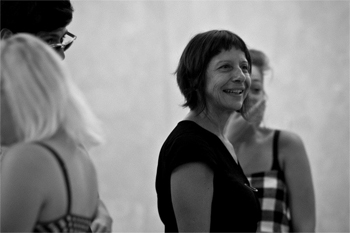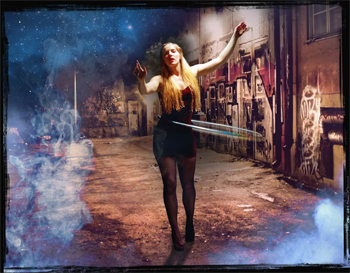Firenza Guidi Dreams from the Second Floor Interview

Firenza Guidi Dreams from the Second Floor Interview
Internationally renowned director Firenza Guidi, from NoFit State Circus in Wales, is creating a dynamic live circus experience featuring NICA's graduating artists. This site-specific performance opens on 26 November and runs until 6 December, at the custom built National Circus Centre in Prahran.
'Every show that I do is a book of dreams", says Firenza Guidi, "I sell dreams. Most things in life are random. Like the sequence of pictures in a dream."
Audiences can expect a unique encounter. The creative process and technical components will be on display in this site-specific work which engages with the NICA National Circus Centre in an innovative way. There is no back stage - this is a performance which will be fabricated in front of the eyes of the audience!
Raw, raucous and infectious, Dreams from the Second Floor will explore different types of dreams from those which come to us at night, sometimes so vivid that we can smell and taste and touch, to those which we carry with us through our waking reality. Witness performers weave their way through their own dreams - where things are uncharted and the world is upside down.
Twenty one multi-talented artists will present high level circus skills on a range of apparatus including: Aerial Ring, Aerial Straps, Contortion, Rope, German Wheel, Hand Balancing, Hula Hoops, Roue Cyr, Dance Trapeze, Tightwire and Tumbling.
NICA is Australia's Centre of Excellence for training in contemporary circus arts. It is one of eight national arts training institutes and offers Australia's only Bachelor of Circus Arts. Graduates of NICA have gone on to pursue exciting careers both locally and internationally and have contributed to the development of Melbourne's vibrant circus arts industry. The course is accredited by Swinburne University of Technology and attracts applicants from around the world.
Tickets are on sale now at www.nica.com.au
The National Institute of Circus Arts (NICA) presents:
Dreams From The Second Floor
Director: Firenza Guidi
26 November – 6 December 2014
NICA National Circus Centre
39 - 59 Green Street, Prahran
Session dates and times:
Dates: 26 - 29 November and 3 - 6 December 2014
Times: 7.30pm, Sat 1.30pm and 7.30pm (90 minutes)
Tickets:
General Admission
Adult $33 / Concession $27 / Child U16 $22
Family (2 adults & 2 children) $88
Family (2 adults & 3 children) $105
Groups (min 10) $25pp
Parental guidance recommended (PG)
Bookings: www.nica.com.au
Interview with Firenza Guidi
Milan-born Firenza is an independent, award-winning theatre, circus and film director, writer and visual artist who has developed a unique performance style through the touring company NoFit State Circus, with productions including Immortal, Tabú and more recently Bianco. For the past twenty years she has been developing her unique style of training and performance, creating small and large scale performances throughout Europe and beyond.
Question: What is it like working with The National Institute of Circus Arts (NICA)?
Firenza Guidi: I loved working with the students and staff. I have enjoyed every minute of my experience here at NICA and met very many talented people. I will treasure it and help build bridges between NICA and the rest of the world. What more could a director want than to dream up worlds than a strong cast of 21 young performers and a creative team of riggers and designers?
 Question: What was the main motivation behind Dreams from the Second Floor? Can you talk us through the inspiration behind the name Dreams from the Second Floor?
Question: What was the main motivation behind Dreams from the Second Floor? Can you talk us through the inspiration behind the name Dreams from the Second Floor?
Firenza Guidi: For many years, I have been fascinated by the notion of dream as a possible metaphor for narrative form. In other words, the narrative structure of a dream could be taken as an inspiration for telling a story in live performance. This becomes particularly true when the performance primarily relies on the body and imagery (and not words) to speak to an audience.
In the creation of this show I have dipped into 5 notions of 'dream". The dreams we have at night and how what we feel, touch, hear, smell and see in our dreams may be more 'real" and vivid than what we experience in our waking state ('I find out a lot about myself by sleeping. Dreams, they are who I am when I'm too tired to be me."Jarod Kintz, This Book is Not for Sale)
Film and performance are also - to use Fellini's phrase - 'a factory of dreams". In film studios the construction of a film is a factory employing hundreds of people to realise the 'dream" which is the artifact. For my research I dipped into imagery from film directors such as David Lynch (American) Federico Fellini (Italian) and Roy Andersson (Swedish) all of whom use montage technique and non-linear narrative structures, creating an artifact which is closer to the language of dream than to the traditional way of telling a story.
By extension, this notion of film and performance being first and foremost a -factory', conjures up a third notion of dream as 'making good" (a better life). The 1960s economic boom in Australia as in other parts of the world meant that the dream of riches, of improving the quality of life by increasing the power to 'produce" and 'consume" goods became the dream of a working class society.
'Industry in Australia was initiated and dominated by factories processing rural products. Products of the land. These industries included the boiling down works, woolscourers, meat preservers and tanners. They provided the foundation for the diversification of manufacturing which followed. Metal manufacturers developed to service them, banks grew to finance them, government expanded to administer them. And the fabric of society as we know it today, was born." Industrial Heartland, Gary Vines; Preface page 1.
These early factories were still very much relying on manpower - cobblers and seamstresses, metal workers and carpenters - all skilled artisans, men and women not yet supplanted by production lines and machines. Even transport and ammunition factories employed, in Australia, as in other parts of the world, a vast number of women as well as men. For some of them, it was their first job, their first salary and their first taste of financial independence from the men in their lives, be them fathers or husbands. The factories were meant to build a better future. Supply an ever growing demand. Give work to women as well as men. And work meant money and independence. That too was a dream.
4. The fourth notion of dream is that of leaving. Leaving home. This is not only relating to emigration, the action of leaving your own country to find a job, it is also travelling, starting an adventure, making a home away from home. 'I'm going to make it elsewhere. Start a new life. I'll find work, new friends, study, see the world, make my own mark, live an adventure, make a fortune, find gold, or just simply scrape by."This too is another dream. Finally, dreaming is aspiring and desiring something - one day 'this" (whatever it may be) will be true. From Martin Luther King 'I have a dream" to any ordinary person's aspiration to do or become something. It could even be, for an adopted child:- 'one day, I will look at the face of my real father"...A moving and a powerful dream.
All of these have inspired the creation of the show. From the performers' own dreams to my brief but intense research into early factories. I've been particularly fascinated by sewing machines. Old Singer sewing machines. A number of calls have been put out and the sewing machines have been brought into the space casting their magic spell on the imagery and narrative.
Question: What should audiences expect from Dreams from the Second Floor?
Firenza Guidi: The performance is viewed in new, innovative ways from within a distinctive set, featuring originally designed aerial and ground structures. The aerial sculptures transform before the audience creating physically and emotionally affecting environments. These shifts in perspective and gravity question how solid and fixed the world around us is?
The pre-recorded and live music will transport the audience through different flights and emotions. Dreams from the second floor has original music from the cast, Lee Stout, David Murray, a live band put together especially for the show and A Cappella singing from the performers. There is a street, drab and ordinary like every other street, but behind it, there is an empty space where everything is possible. The audience are invited to walk through the street of ordinary lives and take a front row seat in the real world to watch the dreams behind the dreamers.
Question: Can you talk us through the process of working with NICA's graduating artists?
Firenza Guidi: In the creative process I focus all my energy into making the performers' voices, bodies, dreams, fantasies and visions become present now and part of our lives today. In doing so, the form translates into a contemporary, sensual, ironic, honest and filmic style performance - ability and accuracy team up with sensuality and immediacy.
In doing this, the performance energises, empowers and makes one feel alive; both performers and spectators.
Question: How does this sort of performance set the graduating artists up for their next steps?
Firenza Guidi: The project will have exposed the students to a new and challenging way of working. It has stretched them physically and mentally and showed them a way of telling a story through their skills and talent. It has also helped them 'create" new material and mobilise their skills to craft original images and not simply show off tricks.
Question: What is unique about Dreams from the Second Floor?
Firenza Guidi: It is raw, raucous and seductive. An energising and empowering experience for both the performers and the audience.
Every performance is a journey into personal and collective history where lost and forgotten faces will turn sharply out of shadow. A play, an installation, a promenade performance where A Cappella singing and live music take the audience through dingy streets and back-alleys, muddy roads and sun-struck desert, dark corridors and bright lanes; where ordinary men and women can make their raucous voices heard. The audience enter a physical world, they do not simply watch from afar. They will be able to feel the performers' touch, hear their breath, witness their bravery and be seduced by their vulnerability.
Question: How can the production have no back stage?
Firenza Guidi: The space is stripped of all covering up paraphernalia and, like the performers, lays bare before the audience's eyes. The performers are 'on stage" the whole time. They inhabit the space which has become their world and within this world they exist as characters for the entire duration of the show and not simply for their own 'act".
Question: What is German Wheel and Roue Cyr?
Firenza Guidi: A German Wheel is a large wheel-shaped apparatus in which performers control the wheel's movements using a combination of their body weight and counter-balance. The Cyr wheel (or Roue Cyr) is an acrobatic device consisting of a single wheel which a performer manipulates using a combination of balance and their body weight to perform artistic movements. NICA has a circus dictionary for anyone who wants to find out more about circus apparatus http://www.nica.com.au/circus-dictionary.php
Question: What's next for you?
Interview by Brooke Hunter
MORE
- Mission: Impossible Fallout
- Glenn Close The Wife
- Allison Chhorn Stanley's Mouth Interview
- Benicio Del Toro Sicario: Day of the Soldado
- Dame Judi Dench Tea With The Dames
- Sandra Bullock Ocean's 8
- Chris Pratt Jurassic World: Fallen Kingdom
- Claudia Sangiorgi Dalimore and Michelle Grace...
- Rachel McAdams Disobedience Interview
- Sebastián Lelio and Alessandro Nivola...
- Perri Cummings Trench Interview



